
Vespertilionidae is a family of microbats, of the order Chiroptera, flying, insect-eating mammals variously described as the common, vesper, or simple nosed bats. The vespertilionid family is the most diverse and widely distributed of bat families, specialised in many forms to occupy a range of habitats and ecological circumstances, and it is frequently observed or the subject of research. The facial features of the species are often simple, as they mainly rely on vocally emitted echolocation. The tails of the species are enclosed by the lower flight membranes between the legs. Over 300 species are distributed all over the world, on every continent except Antarctica. It owes its name to the genus Vespertilio, which takes its name from a word for bat, vespertilio, derived from the Latin term vesper meaning 'evening'; they are termed "evening bats" and were once referred to as "evening birds".
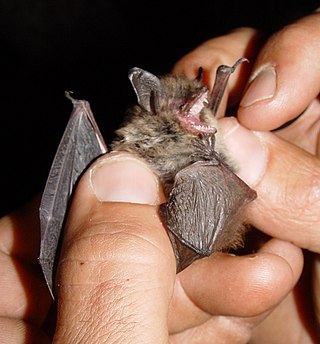
The mouse-eared bats or myotises are a diverse and widespread genus (Myotis) of bats within the family Vespertilionidae. The noun "myotis" itself is a New Latin construction, from the Greek "muós and "oûs", literally translating to "mouse-eared".

The silver-tipped myotis is a species of mouse-eared bat found in a range of lowland habitats in the Americas.

The black myotis is a vesper bat species from South and Central America.

The velvety myotis, is a species of vesper bat from South America.
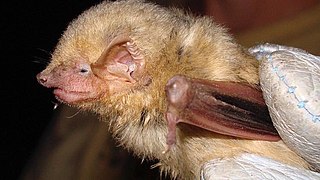
The western yellow bat is a species of vesper bat found in Mexico and the southwestern United States. This species roosts in trees such as Populus fremontii, Platanus wrightii, and Quercus arizonica. If available, the western yellow bat will use the dead fronds that encircle palm trees as a roosting site.
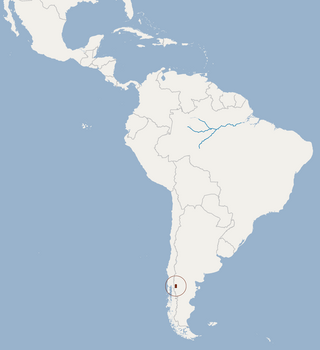
The southern myotis is a species of vesper bat. It is found only in Argentina.
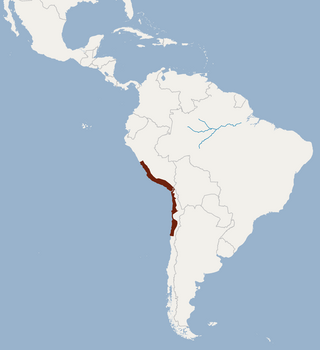
The Atacama myotis is a species of vesper bat in the family Vespertilionidae. It is found in Chile and Peru, an example ecoregion of occurrence being the Chilean matorral.

Myotinae is a subfamily of vesper bats. It contains three genera: Eudiscopus, Myotis, and Submyotodon. Before the description of Submyotodon and analysis of its phylogenetics, as well as a phylogenetic analysis of Eudiscopus, the only member of Myotinae was Myotis.

The Bocharic myotis or Bokhara whiskered bat is a species of mouse-eared bat in the family Vespertilionidae, described in 1950, and indigenous to Tajikistan, and Uzbekistan.
Eugênio Izecksohn was a Brazilian herpetologist. Izecksohn graduated from Universidade Federal Rural do Rio de Janeiro in 1953. Among others, he discovered and scientifically described the flea frog Brachycephalus didactylus, one of the smallest frogs in the world. Several taxa have been named in honour of him, mostly frogs like the tiny B. izecksohni, and the extremely rare—if not already extinct—Bokermannohyla izecksohni, but also a few from other groups like the fish Xenurolebias izecksohni and the bat Myotis izecksohni.
The Barbados myotis is a species of bat found in the Lesser Antilles. It was previously considered a subspecies of Schwartz's myotis, Myotis martiniquensis, but was elevated to species rank in 2012.

Thomas's big-eared brown bat is a species of vesper bat found in South America.
Sir David Attenborough's myotis is a species of small bat in the family Vespertilionidae that is endemic to the Caribbean island of Tobago. Its presence on nearby Trinidad is as yet uncertain. It is the only mammal species currently known to be endemic to Trinidad and Tobago. It was named after famed English naturalist Sir David Attenborough.
Myotis diminutus is a species of mouse-eared bat found in Ecuador and Colombia. It was recently described as a new species in 2011.

Myotis izecksohni is a species of mouse-eared bat that is endemic to Brazil and Argentina.
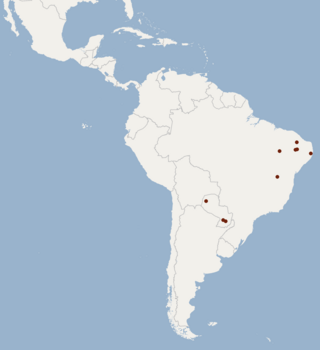
LaVal's myotis is a species of bat found in Brazil and Paraguay.

Lasiurini is a tribe of bats in the family Vespertilionidae. It contains three genera of bats found in the Americas. All three genera were previously considered one genus, Lasiurus, but have since been split from one another. However, the validity of this split is still debated.














